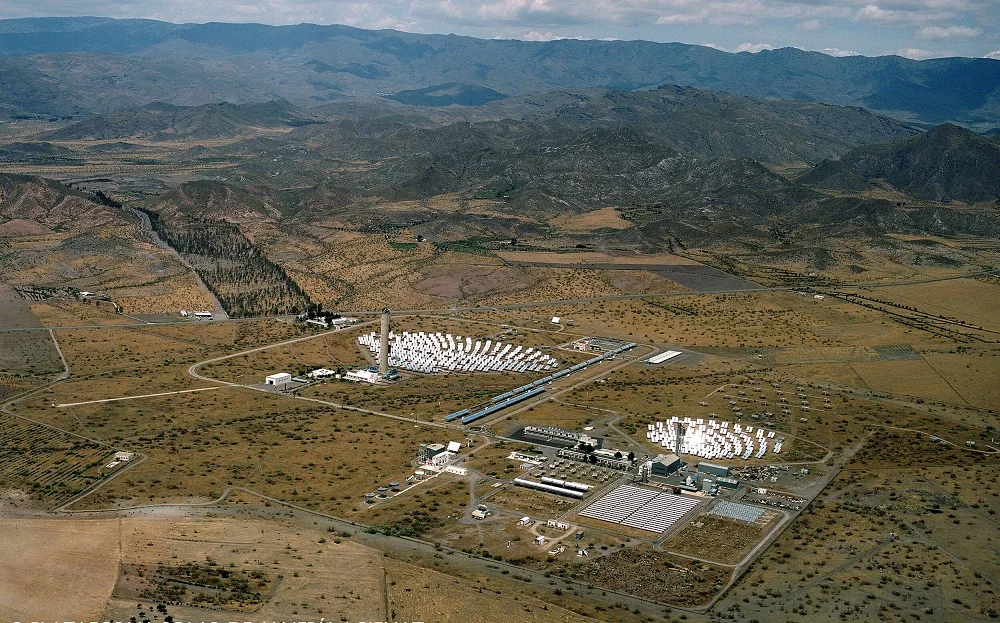As Europe increasingly turns to clean energy sources, EU researchers are also trying to extract hydrogen from sunlight and heat. In July 2023, one particular place in Spain got a lot hotter but didn’t make the headlines, as Southern Europe faced an unprecedented heatwave with temperatures reaching around 45°C. The site was a test site in the province of Almeria and temperatures reached 1,400°C.
great hopes
A dizzying level of heat was created at Plataforma Solar de Almería, where mirrors direct the area’s abundant sunlight into a small spot on a 43-metre tower. The structure uses solar energy to generate extremely high temperatures.
EU researchers believe the platform, which is Europe’s largest testing center for concentrated solar technologies, could also be key to renewable hydrogen production. This type of energy, such as solar panels and wind turbines, could help Europe and other parts of the world move away from fossil fuels that emit greenhouse gases, especially CO.2This accelerates global warming.
“We need real clean energy that will benefit everyone,” said Susana Lorenzo, a chemical engineer at the Hellas Research and Technology Center in Thessaloniki, Greece.
Hydrogen can help green economies around the world because it produces virtually no greenhouse gases when burned and can power hard-to-decarbonize industries, from steel to aerospace.
Renewable energy, including clean hydrogen, is at the heart of REPowerEU’s strategy to phase out Russian fossil fuels this decade and the Green Deal, which aims to make the EU neutral by 2050. The problem is that the hydrogen production process itself often involves energy sources that emit CO2, such as natural gas and coal.2. In 2022, 96% of all hydrogen production in Europe came from natural gas. In fact, a relatively simple way to produce pure hydrogen already exists.
Also read – Study shows oceans take on new color in different parts of the world
This is a method that uses an electric current from a renewable energy source to split water into hydrogen and oxygen. Even in high school science experiments, a process called electrolysis can be done. However, it is not yet widely used due to cost barriers. At the end of 2021, only 4% of global hydrogen production came from electrolysis, according to the International Renewable Energy Agency. And only 1% was produced through electrolysis using renewable energy.
European researchers say it makes sense to look to the sun to find more ways to produce renewable hydrogen. The sun’s rays and the heat they create can be an ideal way to produce pure hydrogen. No electricity needed, just sunlight.
“Our technology is built on top of an existing system (a concentrated solar power plant),” said Lorenzo. “What if these facilities could produce green hydrogen as well as electricity, almost as a bonus?”
Hydrogen production currently emits over 800,000 million tons of CO2.2According to Marcel Burrigter, principal investigator of the Leitat Technology Center in Barcelona, Spain, or about 2% of the world’s total such emissions.
“If we can make it green, we can avoid a large amount of emissions,” said Burrigter.
Research Allies
He and Lorenzou in Thessaloniki share the goal of finding ways to produce hydrogen with zero emissions, and are each leading an EU-funded research project to bring that goal even closer. This is where the solar tower in Almeria comes into play; The region of Europe’s only inland Tabernas desert, with more than 3,000 hours of sunshine a year.
Lorenzo’s project uses the tower’s extreme heat to initiate chemical processes in the reactor that convert water into pure hydrogen without using electricity. The initiative, called HYDROSOL-beyond, is the latest in a series of projects to produce solar hydrogen from water separation. It started in January 2019 and is scheduled for completion by the end of 2023.
Also read – A new study explains the ‘Atlantification’ of the Arctic Ocean
The Boerrigter project uses sunlight as well as heat to start the process of producing pure hydrogen. The initiative, called GH2, will run for three years until the end of September 2025.
Risk reduction
“Currently the main cost driver in green hydrogen production is electricity,” Burrigter said. “Our method makes it unnecessary.”
While the idea of producing hydrogen solely from the sun’s heat or rays is promising, it will take longer to materialize due to ongoing technological challenges. These barriers highlight the role of research, which takes on risks that business-minded businesses often avoid, including publicly funded projects.
Technology beyond HYDROSOL has been developed for nearly 20 years. While a lot of progress has been made during this period, Lorenzou is unsure when large-scale rollout will begin.
“This is already the fifth project in the series,” he said. “I’ve seen technology evolve from what we’re going to build in the lab to small scale installations to the very large scale system we have now.”
At work
Lorenzo said technological improvements, including the Almeria reactor, could take another five years.
“We faced many challenges in building a facility of this magnitude,” he said. “For example, we need to change the design of the reactor to make it more powerful. That’s our priority now.”
The technology behind the GH2 is still in the lab and relatively far from any commercial application. Here, researchers need to scale up chemical processes and streamline them so they can be used in the real world.
“It will likely take 10 to 20 years for this technology to reach the commercial stage,” Burrigter said. “Sounds slow, but we’re moving very fast given the early stage we’re in.”
Also read – Scientists reveal the world’s most polluted cities
He, Lorenzou and other researchers say the goal of producing pure hydrogen using the sun could help prevent catastrophic climate change in the coming years.
“With this technology, we reduce CO emissions2“We produce clean hydrogen without consuming more electricity,” said Burrigter. “We move several stones at once.” Source













